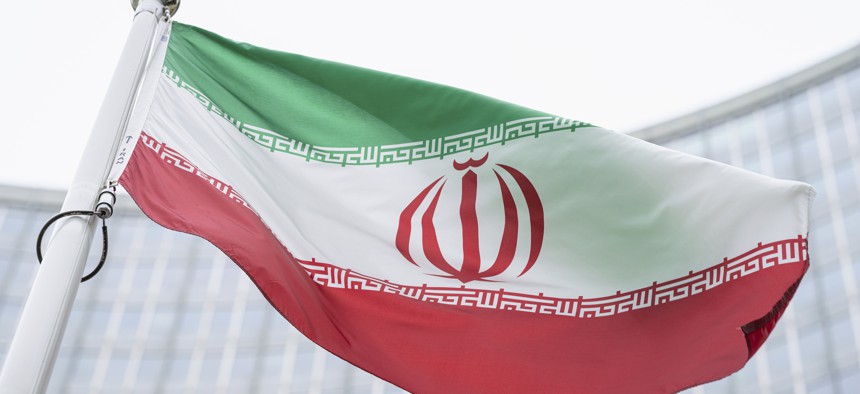
The flag of Iran waves in front of the the International Center building with the headquarters of the International Atomic Energy Agency, IAEA, in Vienna, Austria, May 24, 2021. Associated Press / Florian Schroetter
A Low Bar for Success in Today’s Iran-Nuke Talks
The Nov. 29 session between the U.S., Iran, the European Union, and the rest of the P5+1 has the air of a make-or-break moment.
The Nov. 29 session between the U.S., Iran, the European Union, and the rest of the P5+1 has the air of a make-or-break moment.
For the first time since June, U.S. and Iranian officials are returning to the negotiating table today in an attempt to salvage the 2015 Iran nuclear deal otherwise known as the Joint Comprehensive Plan of Action, or JCPOA. The session is the first time Washington and Tehran have engaged with each other since the inauguration of Iranian President Ebrahim Raisi, a noticeably more hardline figure who happens to be under U.S. sanctions for his past role as Iran’s judiciary chief. U.S. officials, including special envoy Robert Malley, traveled throughout the Middle East and conferring with partners in preparation for the meeting.
The Nov. 29 session between the U.S., Iran, the European Union, and the rest of the P5+1 has the air of a make-or-break moment. The Biden administration is already searching for other options in the event negotiations prove unproductive, most of which rely on the stick of U.S. sanctions. Yet in reality, the resumption of nuclear talks is likely to be far less dramatic than the discourse suggests. What is being broadcasted as an epic fight between two historic adversaries will in all likelihood be a long, hard slog, where competing positions are tabled and the media megaphone is used to make the other side look inept or unserious.
President Biden, who campaigned on ending the Trump administration’s maximum pressure strategy and returning the U.S. to the JCPOA, has made it abundantly clear U.S. sanctions relief will only be offered to Tehran if the Iranians begin complying with their nuclear obligations. Notwithstanding the desire to abolish the pressure strategy, the Biden administration has used it as a negotiating tactic in pursuit of an agreement. Indeed, with the exception of two Iranian entities that were removed from the Treasury Department’s sanctions list as a result of litigation, all Trump-era sanctions on Iran’s energy, manufacturing, banking, automobile, and natural resource industries remain in place
Before the pause in June, talks between Washington and Tehran were at least progressing slowly. While the two delegations experienced their fair share of significant resistance to one another’s negotiating positions, they were seriously attempting to work through their respective grievances. Six rounds of indirect talks were held and several working groups were established to determine how to synchronize the lifting of U.S. nuclear sanctions with Tehran’s return to JCPOA compliance. It helped that the Iranian negotiating team was staffed with the same people who negotiated the nuclear agreement in the first place, and therefore had a personal stake in resurrecting it.
Unfortunately, the U.S. no longer enjoys the luxury of familiar faces. A new Iranian administration has predictably resulted in a new team of Iranian negotiators—and Ali Bagheri Kani, the man leading this team, is far less sympathetic to the nuclear deal than former Iranian Foreign Minister Mohammad Javad Zarif. There is a high probability the Raisi administration are coming to the table with a brand-new list of policy demands. Tehran is telegraphing some of those demands before the meetings, such as the lifting of all U.S. sanctions, including those not related to Iran’s nuclear program. All of this comes as Iranian scientists continue enrich uranium to 60-percent purity and limit the IAEA's access to certain Iranian nuclear facilities.
Will the U.S. and Iran discover a mutually permissible way to move back from the diplomatic brink? The honest answer is we don’t know. If Iran insists on full economic relief up front, then the U.S. is liable to walk away. And if the U.S. demands perfect sequencing or attempts to tie the resumption of the JCPOA to a longer, stronger, and more comprehensive negotiation on Tehran’s foreign policy more broadly, Supreme Leader Ali Khamenei could very well choose to withdraw from the process altogether.
It's incumbent on both parties to prevent this regrettable scenario from taking place—for as difficult and frustrating as diplomacy can be, the other options being deliberated are either recipes for more stalemate or a prelude to a conflict neither country wants to fight. Covert sabotage operations against Tehran’s nuclear facilities are at best a holding-pattern and have prompted Iran to harden those facilities in the past. Cajoling or pressuring China to stop importing Iranian crude oil is unlikely to work, particularly at a time when global energy prices rose to a years-long high and Beijing is griping about an overzealous U.S. China policy. Indeed, every time the U.S. turns up the economic heat on Iran, the Iranian government responds with heat of its own. Doubling down on a failed U.S. maximum pressure campaign would be an exercise in delusion.
Nobody should expect any miracles, for the bar is set low. But neither the U.S. pull the plug out of frustration or without gaming out the alternatives. The U.S. should keep diplomacy and open communication alive regardless of whether the talks succeed or fail, for negotiations are not a concession. And over the long term, Washington would do well to stop inflating Iran’s power, a country balanced by its neighbors, limited in terms of military capability, and more interested in self-preservation than regional expansionism.
Daniel R. DePetris is a fellow at Defense Priorities and a foreign affairs columnist at Newsweek.




